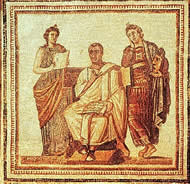
The Romans have been known for their remarkable skill at building and engineering, even since the earliest times. They made bridges across the Tiber River. They constucted a great system of water distribution with aqueducts. The Romans built hundreds of mile of aqueducts that supplied Rome with a fresh water supply. They were also of the few to have sewers to drain the Forum so that the cities were cleaner and healthier. As Rome grew, developed, and conquered, they created roadways across the Empire, which were an amazing feat at the time.
The military engineers and Rome were skilled surveyors that designed numerous expansive projects in the areas that the troops aided in building. A great network of roads, bridges, and canals were built. Also fortified camps, frontier walls, arches, baths, and temples were built.
The military engineers and Rome were skilled surveyors that designed numerous expansive projects in the areas that the troops aided in building. A great network of roads, bridges, and canals were built. Also fortified camps, frontier walls, arches, baths, and temples were built.
Emperor Augustus boasted that he found a city of stone and left it a city of marble. At the end of his reign, a good amount of Rome's buildings were of marble. Romans made a great use of concrete, and eventually used waterproof concrete.
The Romans made many advancements in engineering and were the head of the breakthroughs in engineering at the time.








